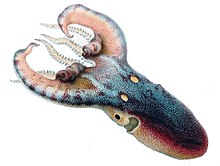Common Blanket Octopus
| Common blanket octopus | |
|---|---|
 |
|
 |
|
| Scientific classification | |
| Kingdom: | Animalia |
| Phylum: | Mollusca |
| Class: | Cephalopoda |
| Order: | Octopoda |
| Superfamily: | Argonautoida |
| Family: | Tremoctopodidae |
| Genus: | Tremoctopus |
| Species: | T. violaceus |
| Binomial name | |
|
Tremoctopus violaceus Chiaje, 1830 |
|
| Synonyms | |
|
|
The common blanket octopus or violet blanket octopus (Tremoctopus violaceus) is a large octopus of the family Tremoctopodidae found worldwide in the epipelagic zone of warm seas. The degree of sexual dimorphism in this species is very high, with females growing to two meters in length, whereas males, the first live specimen of which was seen off the Great Barrier Reef in 2002, grow to about 2.4 cm. Individual weights of males and females differ by a factor of about 10,000.
Males and small females of less than 7 cm have been reported to carry with them the tentacles of the Portuguese man o' war, to whose poison they are immune. It is speculated that these tentacles serve both as a defensive mechanism and possibly as a method of capturing prey. This mechanism is no longer useful at larger sizes, which may be why males of this species are so small. The web between the arms of the mature female octopus serves as a defensive measure as well, making the animal appear larger, and being easily detached if bitten into by a predator.
Ventral view of large female
Dorsal view of large female
Dorsal view of female
Lateral view of adult male with
...
Wikipedia
